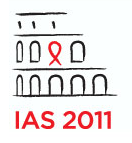No difference in AIDS-free survival in children starting ART with a CD4% between 15%24% compared to deferring until less than 15% in the PREDICT trial
1 August 2011. Related: Conference reports, Paediatric care, IAS 6th Rome 2011.
 Polly Clayden, HIV i-Base
Polly Clayden, HIV i-Base
Information to guide initiation of treatment in children older than one year of age is scarce.
Results from the PREDICT trial – presented as late breakers at both IAS 2011 and the preceding pediatric workshop found that deferring ART until CD4 count fell below 15% or the occurrence of CDC category C events did not affect AIDS-free survival in children compared to starting ART at a CD4 count between 15% and 24%. [1]
PREDICT was conducted in 299 children from nine sites in Thailand and Cambodia between April 2006 and September 2008. Children were randomised to receive immediate ART or defer until their CD4 reached less than 15%. The childrens baseline characteristics are shown in table 1.
The primary endpoints were AIDS free survival at week 144 and neurodevelopmental outcome by Beery visual motor interrogation test.
| Parameter | Immediate arm (n=149) | Deferred arm (n=150) |
|---|---|---|
| Age (years) | 6.4 (3.7-8.0) | 6.4 (4.2-8.7) |
| Female | 77 (52%) | 96 (64%) |
| Thai: Cambodian | 90:59 | 89:61 |
| CD4% | 19 (16-22) | 20 (17-23) |
| HIV RNA (log10) | 4.9 (4.4-5.0) | 4.7 (4.3-5.0) |
| Weight-for-age z-score | -1.3 (-2.0 to -0.8) | -1.3 (-2.0 to -0.8) |
| Height-for-age z-score | -1.6 (-2.5 to -0.8) | -1.7 (-2.6 to -0.9) |
Age, CD4%, HIV RNA, weight-for-age z-score and height-for-age z-score are mean values.
Retention was high in this study (96%). At week 144, 69 (46%) children had started ART with a mean CD4 at initiation of 13.8% (SD+2.8%). Of these, 17 children were <5 years and had a mean CD4 count of 591 cells/mm3 (SD+508) and 52 children were >5 years and had a mean CD4 count of 309 cells/mm3 (SD+141).
AIDS-free survival was 97.9% (95% CI, 93.7 -99.3) in the immediate arm and 98.7% (95%CI 94.7-99.7) in the deferred arm. The incidence of CDC C events or death per 1000 person-years was 7.6 (95%CI 2.5-23.6) in the immediate arm and 4.9 (95%CI 1.2-19.7) in the deferred arm.
The incidence of CDC category B events per 1000 person-years was broadly similar in both arms, 88 (95%CI 61-123) in the immediate arm compared to 110 (95%CI 80-147) in the deferred arm. But there were more episodes of herpes zoster (2 vs 13) and thrombocytopenia (1 vs 10) in the immediate and deferred arms respectively. There were only two episodes of TB, one in each arm.
Weight for age z-score was similar, deferred vs immediate -0.12 (95%CI -0.25 to 0.01), p=0.074. But children grew at a slower rate in the deferred arm, height for age z-score, deferred vs immediate -0.23 (95%CI -0.38 to 0.08), p=0.003.
And at 144 weeks of follow up there was no significant difference by Beery visual motor test between the two arms; Beery score deferred vs immediate, 84.7 vs 86.8, p=0.5.
The investigators noted that at approximately three years of follow up, the rate of progression to AIDS is extremely low in both the immediate and deferred arms. The finding reflects a slow disease progression among HIV-infected children who survive the first year of life without treatment.
comment
This study is important and a bit of a surprise to many as it appears to contradict both adult data and that for young infants. But the median age in the study reflects a population that have survived without treatment for the first few years and therefore selects a group of healthier children without rapid disease progression.
References
Puthanakit T et al. Randomised clinical trial of immediate versus deferred antiretroviral therapy initiation in children older than one year with moderate immunodeficiency: the PREDICT Study (NCT00234091). 3rd International workshop on HIV paediatrics. 15-16 July 2011. Rome, Italy. Oral abstract LB 01.
Also presented at the 6th IAS Conference on HIV pathogenesis, treatment and prevention. 17-20 July 2011. Rome, Italy. Poster abstract TULBPE023.

